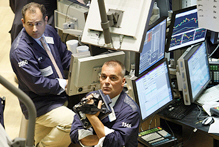
Typical street scene in Santa Ana, El Salvador. (Photo: iStock)
IMF Survey: Global Economy Likely to Slow More
December 11, 2007
- New risks threaten global growth
- Global imbalances still challenging
- Currency moves reflect new uncertainties
Rising oil prices, financial market turmoil, and a sliding dollar have grabbed the headlines in recent months.

Traders on the New York Stock Exchange: financial market turbulence and the rise in oil prices have dampened the global outlook (photo: Timothy Clary/AFP/Getty)
Interview with John Lipsky
Underlying these developments, however, is the emergence of record external payments imbalances and the associated capital flows. The persistence of these imbalances undermines confidence that the global growth expansion can be sustained, says IMF First Deputy Managing Director John Lipsky. Speaking with the IMF Survey magazine, he argues that it is more urgent than ever that the major players—China, the Euro area, Japan, Saudi Arabia, and the United States—follow through on promised policy plans that were announced last April as part of the IMF's Multilateral Consultations on Global Imbalances.
IMF Survey magazine: Financial conditions remain unsettled and oil prices have continued to rise. How do you assess the global economic outlook and the risks to it?
Lipsky: Ongoing turbulence in financial markets and a new rise in oil prices have dampened the global outlook since the October update of our World Economic Outlook—which forecast growth of 4. 8 percent in 2008, down from 5.2 percent in 2007. In particular, the U.S. growth outlook, which we had perceived already as likely to be sub par in 2008, has become subject to somewhat greater risks. The heightened risks reflect both the depth of the housing sector's difficulties and the financial market strains that now appear to be more widespread and of longer potential duration than had been anticipated previously.

Lipsky: "Despite the risks, the most likely outcome is continued global expansion." (photo: IMF)
In Europe and Japan, growth appears to be decelerating after solid advances in the third quarter, and their outlooks would be affected if risks to U.S. growth were to materialize. Emerging markets have been the engine of global growth in 2007, and so far, they remain largely unaffected by the financial market turmoil. But the combination of higher energy prices and weaker growth prospects in advanced economies could dampen the outlook also for emerging markets. Nonetheless, despite these risks, the most likely outcome is a continued global expansion.
IMF Survey: U. S. polls indicate that a growing number of people think that the recession is around the corner. What do you think?
Lipsky: Never say never, but the latest indicators do not justify such a conclusion. Keep in mind that consumer spending is the largest single component of any economy, and the principal determinant of consumer spending is household income. Over the past year or so, employment growth and wage increases have decelerated, but they both continue to grow. So long as U.S. household income continues to expand, it's reasonable to expect consumption expenditures to increase.
As for corporate profits, they've come under some pressure in the past few quarters, but they're at all-time highs—in terms of both profit margins and absolute amounts. Moreover, the U.S. corporate sector in general isn't heavily leveraged. Nonetheless, the increased risks warrant paying close attention to new data as they appear.
IMF Survey: What's the bottom line?
Lipsky: I'm cautiously optimistic. As long as corporate profits remain solid, businesses will continue to expand, jobs will continue to grow, income will grow, and the economy should remain in positive territory. This outcome cannot be taken for granted, however, and monetary policy flexibility is required.
IMF Survey: How do the hefty global current account imbalances fit into this picture?
Lipsky: The easiest way to understand the concerns with global imbalances is that the global expansion from 2002 until 2007 was much stronger and better balanced than had been anticipated. The surprise, however, was that it was also associated with a continued widening of the U.S. balance of payments deficit—which hit record highs in 2005-2006. An explanation is that U.S. domestic spending was growing at a much faster pace than in many of the United States' principal trading partners. In other words, growth in the rest of the world was depending to an unusual extent on the strength of U.S. demand.
It was clear to everyone that this wasn't a healthy situation, and there was a need for better balance in domestic demand growth around the world if the expansion were to be sustained. Indeed, that was the goal of the Multilateral Consultations on Global Imbalances that the IMF initiated in mid-2006—involving China, the euro area, Japan, Saudi Arabia, and the United States. The resulting policy plans that the five principal players announced in April 2007 were agreed by the participants to be in their own interests and at the same time supportive of the general goal of sustaining growth while reducing imbalances. Implicitly, these plans recognize that U.S growth over the next few years will depend, to an unusual extent, on the growth of domestic demand in its trading partners.
IMF Survey: Do the new risks to the global outlook alter what each of these parties needs to do or make the implementation of the policy plans more urgent?
Lipsky: The new risks add urgency. The rise in energy prices has created new strains and increased imbalances, further boosting the payments surplus of energy exporters. At the same time, the financial turbulence has particularly affected the United States, but surprising interlinkages also have appeared with markets and economies abroad. One of the uncertainties of the moment is the exact magnitude of the impact the financial difficulties will have on real economic performance. That's why it's best to say that the turbulence in financial markets so far has heightened the risk to the outlook—the effect that it will have on economies is not yet clear. Nonetheless, it is important that the key economies are seen to be following appropriate policies.
IMF Survey: How are the parties doing on implementation?
Lipsky: All of them had agreed that the policy plans were medium-term—that is, aimed at sustaining growth over the next few years―but they also agreed that they needed to get started directly on their implementation. That's why it's not too early to say that there have been some positive developments. For example, the U.S. dollar's decline has been consistent with global adjustment in that it has helped to boost U.S. exports and to reduce the non-oil deficit in the U.S. balance of payments. The dampening of U.S. domestic demand growth also has been consistent with a better balance in the global economy.
That said, there's still much to be done. Efforts to strengthen domestic demand outside the United States have been uneven and had uncertain effects. In addition, the most recent currency moves seem to have worked against the adjustment process in that the real effective exchange rates—that is, trade-weighted and inflation-adjusted—of many important economies, especially those with pegged exchange rates (such as some oil exporters and emerging markets) have depreciated even though their balance of payments is in large surplus.
IMF Survey: The burden of adjustment has fallen on certain currencies, such as the euro. Why has the adjustment process been so skewed?
Lipsky: If some currencies are undervalued and they're becoming increasingly so on a real effective basis, by definition there must be currencies that are becoming stronger than is consistent with medium-term equilibrium. Most recently, we find that the euro is by now somewhat on the strong side with regard to our views of medium-term equilibrium.
It was the expectation of the participants in the Multilateral Consultation that the full implementation of the set of policy plans would support a sustainable adjustment process and therefore would tend to produce currency movements that were both orderly and at the same time supportive of the adjustment process. But in a world of floating exchange rates, the influence of large-scale, cross-border capital flows can move currencies in the short run in ways that aren't necessarily consistent with either policy intentions or long-term logic.
IMF Survey: So the answer would be either greater flexibility for those fixing their currencies and, for some, unpegging from the dollar?
Lipsky: In the case of China, for example, the authorities indicated their intent to increase exchange rate flexibility with reference to a basket of currencies. But the primary focus of the Multilateral Consultation policy plans was not on currency policy.
Remember, those major economies with floating exchange rates have no direct control over rate movements. So the most powerful approach to attaining the dual goals is the implementation of the full set of policies—including structural reforms—which will promote orderly and sustained adjustment. And that, in turn, should encourage financial markets, and currency markets in particular, to move in directions consistent with long-term fundamentals.


